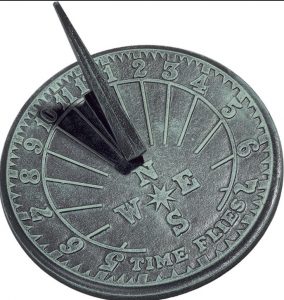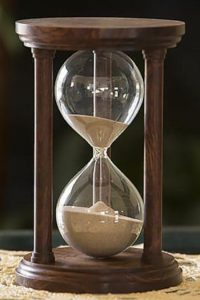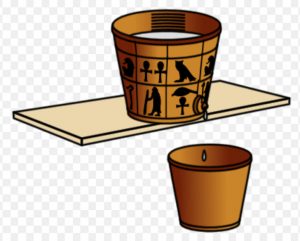Question 1 Name the standard units of time?
Question 2 Name the devices which were used in ancient times for measuring time?
Question 3 How was the time measured in ancient times?
Question 4 How sundial helps to find the time during ancient period?
Question 5 How sand clock helps to find the time during ancient period?
Question 6 How water clock helps to find the time during ancient period?
Contents
Time
Time is a moment or duration in which things occur. We measure time with the help of clocks and watches.
Measurement of Time in Ancient Times
In ancient times, people used some natural events which repeated regularly after fixed time intervals, to measure time.
It was observed that full moon occurs regularly after fixed time interval and the sunrise also occurs regularly after fixed time interval. So, the two natural periodic events which were used in ancient times to measure time were the occurrence of full moon and sunrise.
(1) The time from one full moon to the next full moon was called a month.
(2) The time from one sunrise to the next sunrise was called a day.
The important time measuring devices used in ancient times were : Sundial, Sand clock and Water clock.
Sundial
A sundial measures time by the position of the shadow cast by the sun.The sun rises in the east, appears to move in the sky during the day, and finally sets in the west. Due to this apparent movement of the sun in the sky , the position of shadow of a vertical object on the ground changes continuously throughout the day.
The sundial has a triangular blade which is fixed vertically on a dial marked with hours of the day.The sun casts a shadow of this vertical blade on the dial. As the position of sun changes in the sky, the position of shadow of blade on the dial also changes. The position of shadow of vertical blade on the dial gives the time of the day.
Some historical sundials still exist in India at Jantar Mantar in Delhi and at Jaipur in Rajasthan
Sand Clock
Sand clock is also known as sand-glass or hour-glass. The sand clock uses the flow of sand (from one glass bulb to another) to measure time. The length of time taken by the sand to pass from one bulb of the sand clock to the other, gives a constant time interval. A sand clock consists of two glass bulbs joined together through a narrow tube.
Some sand is filled in one of the glass bulbs. The two glass bulbs are closed at the outer ends. When the sand clock is kept in such a way that the sand is in the upper bulb, the entire sand flows down to the lower bulb slowly, in a fixed time interval. When the sand clock is to be used again, it is turned upside down so that the sand containing bulb comes at the top. The sand clock (or sand glass) is usually filled with so much sand that it takes one hour to fall from the upper bulb to the lower bulb. This is why sand clock (or sand-glass) is also called an hour-glass
Water Clock
A water clock uses the rate at which water drips from one vessel to another to measure time intervals. Water was allowed to drip from one vessel to another vessel kept at a lower level. The time taken by the entire water to drip from upper vessel to lower vessel was used for measuring time intervals. Every time the upper vessel is filled with water, its water takes exactly the same time to drip into the lower vessel.
Units of Time
The standard unit of measuring time is second. The symbol of second is ‘s’. The standard unit of time is also called basic unit of time. The larger units of time than second are minute and hour. The symbol of ‘minute’ is ‘min’ and the symbol of hour’ is h.
Time is normally measured in the units of hours, minutes and seconds.
1 hour = 60 minutes
1 minute = 60 seconds
The bigger units of time for expressing longer time intervals are : Day, Month and Year.
24 hours =1 day
30 days =1 month
12 months =1 year
The still bigger units for expressing very long time intervals are decade, century and millenium.
10 years =1 decade
100 years (or 10 decades)= 1 century
1000 years (or 10 centuries)=1 millenium
Different units of time are used depending on the purpose for which they are to be used.
1) The time taken to cover the distance between our home and school should be expressed in minutes (or hours) and not in days or months.
2) The age of a person should be expressed in years and not in days or hours.
3) The ages of stars and planets are expressed in billions of years.
The two extremely small units of time which are used for expressing very, very small time intervals are ‘microsecond and ‘nanosecond’.
Periodic Motion
A motion which repeats itself at regular intervals of time is called periodic motion.
Clocks and watches which are used for measuring time are based on the principle of periodic motion.
The pendulum clock used for measuring time is based on the periodic motion of a pendulum.



Thanks
This notes is very useful for me.
Wow nice
Notes
These notes are very useful for me
Thanks
Good explanation
This notes is very useful for me
Thanks you
This one is very useful for me for my study.
Thanks you you.
Have a nice day ahead.
This is very helpful, thank you.
Hi , Thanks a lot , Very Briefly Explained…It appeared to me very easy and simple , CRYSTAL CLEAR …
It was very helpful to my studies and for exams … This topic is actually tough for me …Once I got to know about this topi c..it was very easy . Now i am perfect at this Concept…. :->
Regards , Srinitha
Thank you Shilpi Nagpal.
:->
Thankyou so much for these notes, I needed to make a presentation and got these points to mention on my PPT.
Thanks the notes are important & easy then short
This notes is very useful for me
Thankyou